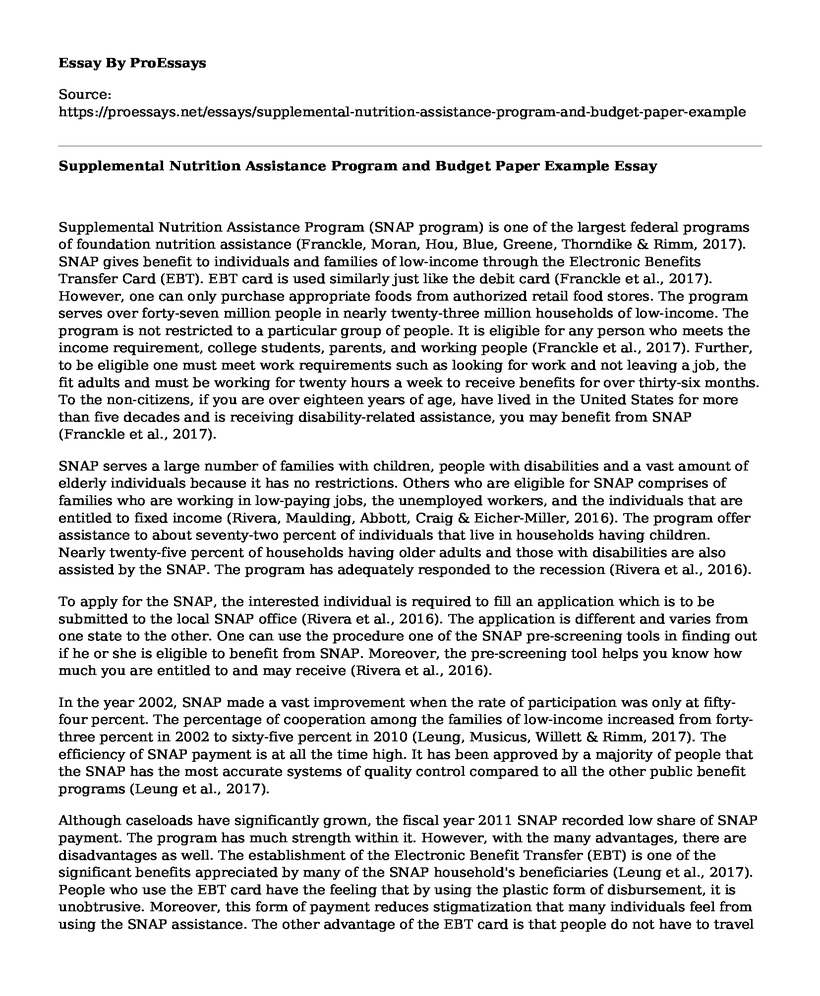Supplemental Nutrition Assistance Program (SNAP program) is one of the largest federal programs of foundation nutrition assistance (Franckle, Moran, Hou, Blue, Greene, Thorndike & Rimm, 2017). SNAP gives benefit to individuals and families of low-income through the Electronic Benefits Transfer Card (EBT). EBT card is used similarly just like the debit card (Franckle et al., 2017). However, one can only purchase appropriate foods from authorized retail food stores. The program serves over forty-seven million people in nearly twenty-three million households of low-income. The program is not restricted to a particular group of people. It is eligible for any person who meets the income requirement, college students, parents, and working people (Franckle et al., 2017). Further, to be eligible one must meet work requirements such as looking for work and not leaving a job, the fit adults and must be working for twenty hours a week to receive benefits for over thirty-six months. To the non-citizens, if you are over eighteen years of age, have lived in the United States for more than five decades and is receiving disability-related assistance, you may benefit from SNAP (Franckle et al., 2017).
SNAP serves a large number of families with children, people with disabilities and a vast amount of elderly individuals because it has no restrictions. Others who are eligible for SNAP comprises of families who are working in low-paying jobs, the unemployed workers, and the individuals that are entitled to fixed income (Rivera, Maulding, Abbott, Craig & Eicher-Miller, 2016). The program offer assistance to about seventy-two percent of individuals that live in households having children. Nearly twenty-five percent of households having older adults and those with disabilities are also assisted by the SNAP. The program has adequately responded to the recession (Rivera et al., 2016).
To apply for the SNAP, the interested individual is required to fill an application which is to be submitted to the local SNAP office (Rivera et al., 2016). The application is different and varies from one state to the other. One can use the procedure one of the SNAP pre-screening tools in finding out if he or she is eligible to benefit from SNAP. Moreover, the pre-screening tool helps you know how much you are entitled to and may receive (Rivera et al., 2016).
In the year 2002, SNAP made a vast improvement when the rate of participation was only at fifty-four percent. The percentage of cooperation among the families of low-income increased from forty-three percent in 2002 to sixty-five percent in 2010 (Leung, Musicus, Willett & Rimm, 2017). The efficiency of SNAP payment is at all the time high. It has been approved by a majority of people that the SNAP has the most accurate systems of quality control compared to all the other public benefit programs (Leung et al., 2017).
Although caseloads have significantly grown, the fiscal year 2011 SNAP recorded low share of SNAP payment. The program has much strength within it. However, with the many advantages, there are disadvantages as well. The establishment of the Electronic Benefit Transfer (EBT) is one of the significant benefits appreciated by many of the SNAP household's beneficiaries (Leung et al., 2017). People who use the EBT card have the feeling that by using the plastic form of disbursement, it is unobtrusive. Moreover, this form of payment reduces stigmatization that many individuals feel from using the SNAP assistance. The other advantage of the EBT card is that people do not have to travel anywhere to receive benefits (Leung et al., 2017). The benefits directly get disbursed to the card. Again, the card eradicated discrimination with regards to race, national origin, political beliefs, religion, status or gender (Leung et al., 2017).
References
Franckle, R. L., Moran, A., Hou, T., Blue, D., Greene, J., Thorndike, A. N., ... & Rimm, E. B. (2017). Transactions at a Northeastern supermarket chain: differences by Supplemental Nutrition Assistance Program use. American journal of preventive medicine, 53(4), e131-e138.
Leung, C. W., Musicus, A. A., Willett, W. C., & Rimm, E. B. (2017). Improving the Nutritional Impact of the Supplemental Nutrition Assistance Program:: Perspectives From the Participants. American journal of preventive medicine, 52(2), S193-S198.
Rivera, R. L., Maulding, M. K., Abbott, A. R., Craig, B. A., & Eicher-Miller, H. A. (2016). SNAP-Ed (Supplemental Nutrition Assistance Program-Education) Increases Long-Term Food Security among Indiana Households with Children in a Randomized Controlled Study-4. The Journal of nutrition, 146(11), 2375-2382.
Cite this page
Supplemental Nutrition Assistance Program and Budget Paper Example. (2022, Oct 08). Retrieved from https://proessays.net/essays/supplemental-nutrition-assistance-program-and-budget-paper-example
If you are the original author of this essay and no longer wish to have it published on the ProEssays website, please click below to request its removal:
- Medicine Literature Review: History and Background of Salmonella
- Rhetorical Analysis Essay: Is It Necessary to Have Health Insurance
- Healthcare Leadership in Terms of Quality and Safety Activities Essay Example
- Assignment Example on Maximizing Options & Investment
- Essay on Unravelling Qualitative Research in Nursing: Analysing Approach, Interpretation and Presentation
- Essay on Teachers and Students: Building a Caring Relationship in Childcare Centers
- Essay Sample on EBP among Nurses: Preventing VAP with Oral Chlorhexidine







